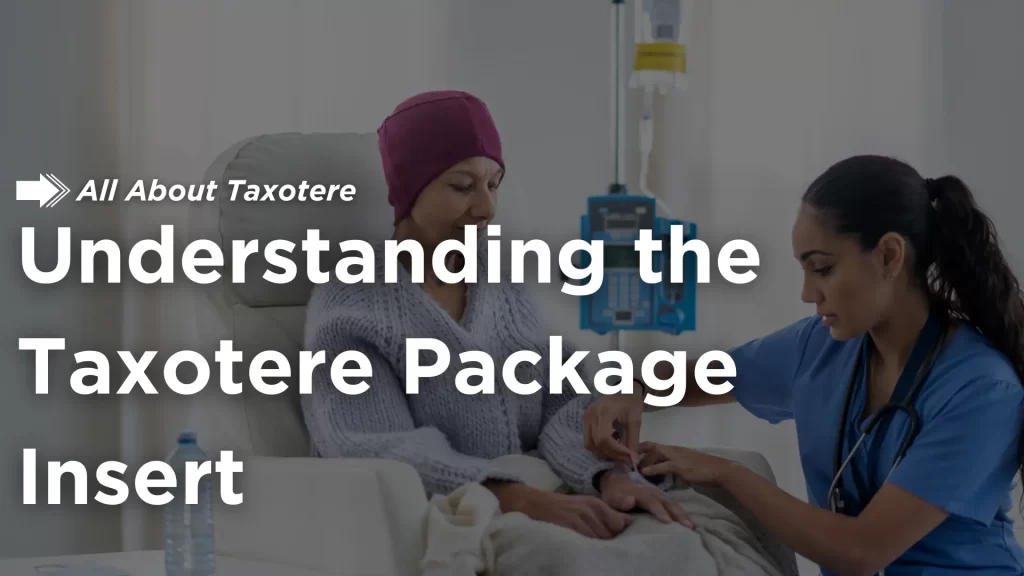
If you or a loved one has undergone chemotherapy treatment with Taxotere, you may have questions about the drug’s package insert. Understanding the Taxotere package insert can be difficult for some. This document contains crucial information about the medication, its uses, and potential side effects. As ongoing litigation surrounds Taxotere, understanding this insert becomes even more critical. Hotze Runkle PLLC aims to illuminate this important document and its implications for patients and their families.
The Significance of the Package Insert
The package insert, also known as the prescribing information or drug label, is the official guide for healthcare professionals and patients. It outlines the drug’s approved uses, dosage instructions, warnings, and potential side effects. For Taxotere, this insert is pivotal in the current legal landscape.
Critical Components of the Taxotere Package Insert
The insert begins by listing the approved uses for Taxotere. It includes treatment for various types of cancer, such as breast cancer, non-small cell lung cancer, prostate cancer, gastric adenocarcinoma, and head and neck cancer. This section helps establish the drug’s intended purpose and the conditions for which doctors may prescribe it.
The dosage and administration section provides detailed instructions on how healthcare providers should administer Taxotere. It includes information on proper dosing, preparation of the medication, and administration techniques. Understanding this section becomes crucial when evaluating whether the drug was administered correctly in individual cases.
The most critical section for legal purposes is the warnings and precautions that outline potential risks associated with Taxotere use. This section should include all known severe side effects and complications that may arise when you start treatment.
The adverse reactions section lists common and less common side effects reported during clinical trials and post-marketing surveillance. This section becomes a focal point in legal cases, especially when discussing undisclosed or underreported side effects.
The insert also describes how Taxotere may interact with other medications, helping healthcare providers make informed decisions about concurrent treatments and potential risks. Information about the drug’s use in specific populations, such as pregnant women, nursing mothers, pediatric patients, and elderly individuals, guides healthcare providers in making treatment decisions for these groups.
Technical details about the drug’s mechanism of action, how the body processes it, and other pharmacological information appear in the clinical pharmacology section. While complex, this information can prove valuable in understanding how the drug works and potential reasons for adverse effects.
The insert includes summaries of clinical trials that supported the drug’s approval, providing insight into the evidence base for Taxotere’s efficacy and safety profile.
Analyzing the Taxotere Package Insert: What It Says and What It Doesn’t
Several key points emerge when examining the Taxotere package insert in the context of ongoing litigation. One of the primary issues in Taxotere lawsuits involves the alleged failure to disclose specific side effects adequately. The package insert should have a Taxotere side effects list detailing all known significant side effects. Plaintiffs argue, however, that some severe side effects, such as permanent hair loss (alopecia) and canalicular stenosis, received insufficient attention or disclosure.
Package inserts undergo revisions as new information about cancer treatment becomes available. Tracking these changes can reveal when the manufacturer became aware of certain risks and how promptly they updated the insert. This timeline often becomes a crucial element in legal proceedings.
Interestingly, package inserts for the same drug can vary between countries. Comparing Taxotere’s U.S. package insert with those from other nations may reveal discrepancies in reported side effects or warnings. Such differences can raise questions about the manufacturer’s global disclosure practices.
Don’t know how to read Taxotere package inserts? The way information appears in the package insert matters. Clear language regarding side effects can lead to understanding among healthcare providers and patients. Legal teams often scrutinize the wording to determine if it adequately conveys the risks associated with Taxotere use.
Not all information in a package insert receives equal attention. The placement and emphasis of specific warnings can influence how healthcare providers perceive and communicate risks to patients. Legal arguments may focus on whether critical warnings received sufficient prominence in the document.
While package inserts primarily focus on approved uses, they may also include information about known off-label uses. The presence or absence of such information can become relevant in cases where patients received Taxotere for conditions not explicitly approved by the FDA.
Package inserts should reflect new safety information gathered after the drug’s approval. The timeliness and completeness of updates based on post-marketing surveillance data often come under scrutiny in legal proceedings.
FDA Oversight and Package Insert Regulations
The U.S. Food and Drug Administration (FDA) is crucial in overseeing package inserts. Understanding the Taxotere package insert with this regulatory framework provides significant context for Taxotere litigation.
The FDA reviews and approves the initial package insert as part of the drug approval process. This review aims to ensure that the insert accurately reflects the drug’s safety and efficacy profile based on available data.
The FDA continues to monitor drugs after approval and can require updates to package inserts based on new safety information. The agency’s communications with Sanofi-Aventis regarding Taxotere often become relevant in legal proceedings.
In cases of severe or life-threatening risks, the FDA label Taxotere has may include a “black box” warning — the most vital type of warning in prescription drug labeling. The presence or absence of such warnings for Taxotere and the timing of their addition, if present, can significantly impact legal arguments.
The Role of Package Inserts in Taxotere Litigation
 As lawsuits against Sanofi-Aventis proceed, the Taxotere package insert remains a central piece of evidence. Legal teams scrutinize this document to build their cases. Understanding the Taxotere package insert can be integral in your lawsuit.
As lawsuits against Sanofi-Aventis proceed, the Taxotere package insert remains a central piece of evidence. Legal teams scrutinize this document to build their cases. Understanding the Taxotere package insert can be integral in your lawsuit.
Many lawsuits allege that Sanofi-Aventis failed to adequately warn patients and healthcare providers about certain risks associated with Taxotere. The package insert serves as primary evidence in these claims.
Legal teams often examine how quickly Sanofi-Aventis updated the package insert when new safety information became available. Please update this crucial document to support negligence claims.
Lawyers may compare Taxotere’s package insert with those of similar chemotherapy drugs. This comparison can highlight differences in risk disclosure practices among manufacturers.
Medical experts often review the package insert as part of their analysis in Taxotere cases. Their interpretation of the document and its adequacy in communicating increased risks can significantly influence legal proceedings.
Lawyers may examine how information from the package insert is translated into patient education materials. Discrepancies between these Taxotere prescribing information and documents can raise questions about the manufacturer’s communication practices.
Contact Hotze Runkle PLLC
Understanding the Taxotere package insert can be difficult for patients and their relatives. The Taxotere package insert is crucial in ongoing litigation and patient care. Understanding its contents, limitations, and implications provides valuable insight into the complex issues surrounding this medication. As legal proceedings continue, the role of drug labeling in ensuring patient safety and informed consent will likely receive increased attention. Medical advice about side effects can also affect your lawsuit, as cancer cell treatment can be a delicate thing to handle.
If you or a loved one has experienced unexpected side effects after Taxotere treatment, you may have legal options. Our team at Hotze Runkle PLLC stands ready to review your case and provide guidance on potential next steps. Contact our Taxotere lawyers online or at (800) 763-6155 to discuss your experience and learn about your rights.